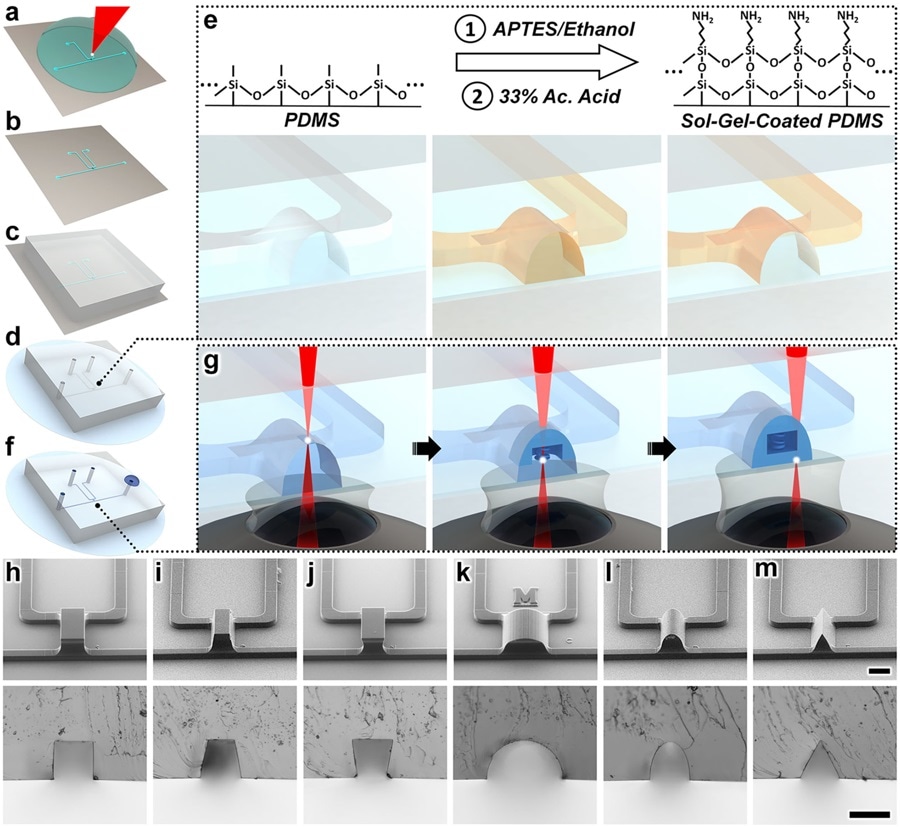Jan 24 2019
The smallest ever 3D-printed fluid circuit element, or microfluidic diode, has been developed by engineers from the University of Maryland (UMD). The diode is so tiny that 10 of it could be placed along the width of a strand of human hair.
 Sol-gel-based in-situ direct laser writing concept. (Image credit: Björn Högberg)
Sol-gel-based in-situ direct laser writing concept. (Image credit: Björn Högberg)
The microfluidic diode makes sure that fluids move in just one direction—a feature crucial for products such as implantable devices that directly release therapies into the human body. It also represents the first-ever application of a 3D nanoprinting approach that overcomes the complexity and cost barriers that earlier hindered advancements in areas such as drug delivery and personalized medicine.
Just as shrinking electric circuits revolutionized the field of electronics, the ability to dramatically reduce the size of 3D printed microfluidic circuitry sets the stage for a new era in fields like pharmaceutical screening, medical diagnostics, and microrobotics.
Ryan Sochol, Assistant Professor in Mechanical Engineering and Bioengineering, A. James Clark School of Engineering, UMD
Sochol, in collaboration with graduate students Andrew Lamont and Abdullah Alsharhan, has described the new approach in a paper published in the open-access journal Nature: Scientific Reports on January 23rd, 2019.
In recent years, researchers have exploited the emerging technology of 3D nanoprinting to design medical devices and develop “organ-on-a-chip” systems. However, the intricacies involved in pushing nutrients, pharmaceuticals, and other fluids into such small environments without any leakage, as well as the costs of dealing with those intricacies, rendered the technology unworkable for a majority of the applications that need precise fluid control.
Rather, scientists were limited to additive manufacturing technologies that can only print features considerably larger than the new UMD fluid diode.
“This really put a limit on how small your device could be,” stated Lamont, a bioengineering student who created the strategy and led the analyses as part of his doctoral research. “After all, the microfluidic circuitry in your microrobot can’t be larger than the robot itself.”
The aspect that makes the Clark School researchers’ approach stand apart is its use of a method called sol-gel, which enabled them to secure their diode with the walls of a microscale channel printed with a common polymer. The minuscule architecture of the diode was then directly printed inside the channel, one layer over the other, from the top to the bottom of the channel.
The outcome is a completely sealed, 3D microfluidic diode built at only a small proportion of the cost and in reduced time compared to earlier strategies.
The strong seal developed by the researchers will prevent contamination of the circuit and make sure any fluid pushed through the diode does not get released at the wrong place or time. The seal was strengthened further by reshaping the microchannel walls.
Where previous methods required researchers to sacrifice time and cost to build similar components, our approach allows us to essentially have our cake and eat it too. Now, researchers can 3D nanoprint complex fluidic systems faster, cheaper, and with less labor than ever before.
Ryan Sochol, Assistant Professor in Mechanical Engineering and Bioengineering, A. James Clark School of Engineering, UMD